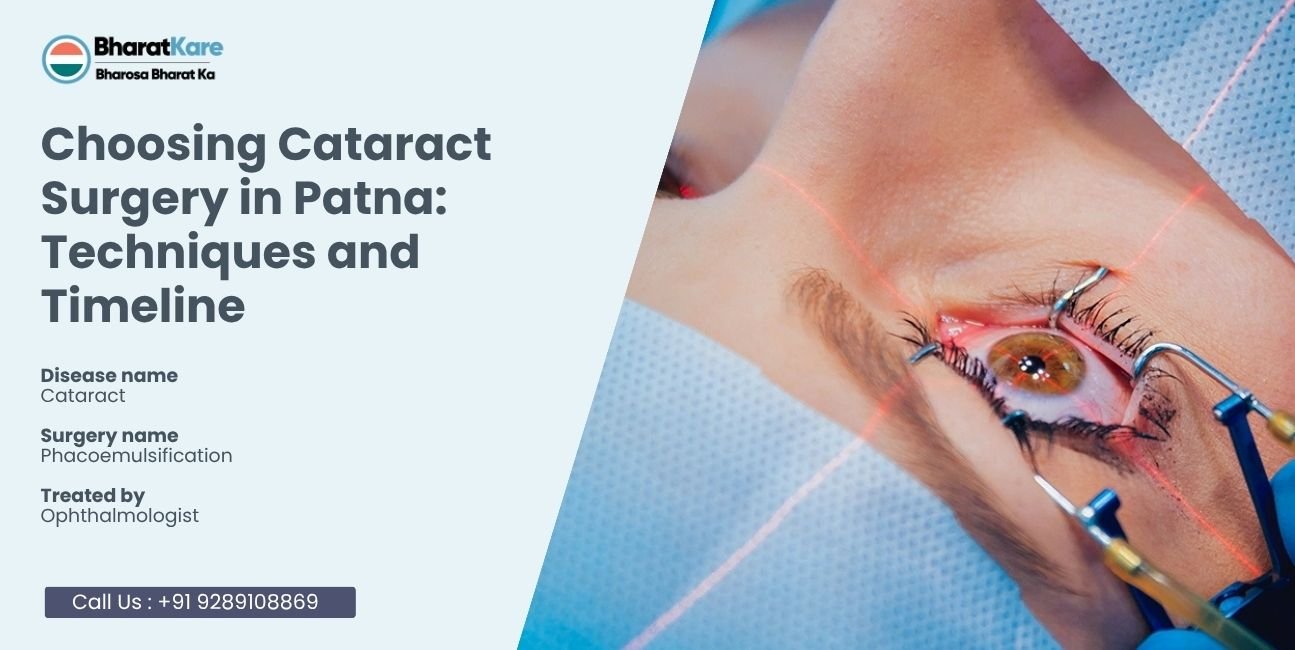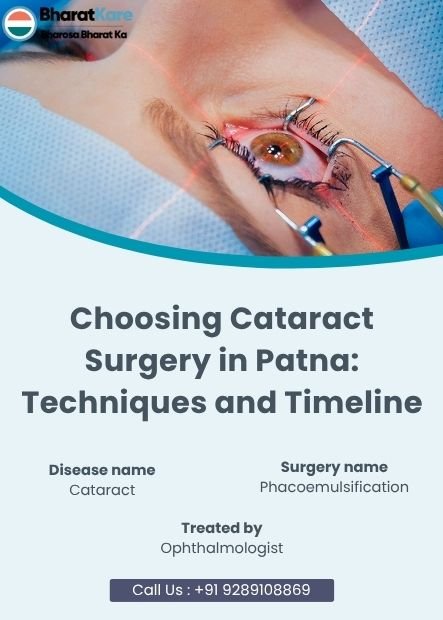Choosing Cataract Surgery in Patna: Techniques and Timeline
So there I was last Tuesday, sitting across from Mrs. Sharma – a lovely 68-year-old who’d been putting off her cataract surgery for what felt like forever. She looked at me with this mix of frustration and fear and said, “Doctor, I can’t even see my grandson’s cricket matches properly anymore. But honestly? The whole idea of someone operating on my eyes terrifies me.”
I get it. I really do. And you know what? She’s not alone in feeling this way. Probably eight out of ten patients I see express the exact same concerns about choosing cataract surgery in Patna. They’re worried about the procedure, confused about their options, and frankly, a bit overwhelmed by all the medical jargon floating around.
But here’s the catch: cataract surgical procedures have changed so radically that what we’re doing now nearly resembles what your parents might have undergone. We’re referring to methods that are really comfortable for patients as well as extremely safe.
Look, I have been working on this for years now and I still get delighted discussing the improvements Patna’s cataract surgery environment has undergone. Everything—the technology, the methods, even the recuperation process—has improved so much. What formerly was a major, frightening operation is now something most of my patients characterize as “easier than visiting the dentist. “
I want you to be sure about your choices by the time we finish speaking today. We’ll go over everything you need to know about what’s accessible right here in Patna, whether you’re just beginning your cataract surgery study or you’re prepared to set that meeting you’ve been postponing.


What’s Actually Happening Inside Your Eye?
Understanding what is happening helps all other things make sense; so, let’s begin with the fundamentals. Consider the windshield of your car on a gloomy morning; that’s more or less what is going on inside your eye, except it won’t clear with the defroster.
Your eye has this natural lens that’s supposed to be crystal clear. When you’re young, it’s flexible and transparent, focusing light perfectly. But as we age – and this happens to pretty much everyone – proteins in that lens start clumping together. It’s like having tiny clouds forming inside your eye.
Here is what’s fascinating now. Some people see this slowly over years. Others wake up one day and realize they can’t read the newspaper without squinting. Others may ponder, “Hmm, my night vision isn’t what it used to be,” or “Why does everything look so dim? “
I had one patient – let’s call him Rajesh – who didn’t realize how bad his cataracts had gotten until his daughter pointed out he’d been putting salt in his tea instead of sugar for weeks. That’s when it hit him that maybe, just maybe, it was time to do something about his vision.
The difficult element is that cataracts grow so slowly that our brains become rather adept at compensating. You can begin holding books more far off, or maybe you avoid driving at evening without truly considering why. Your brain is essentially working overtime to make sense of the hazy pictures it’s getting.
But at some point, squinting or stronger lighting will be useless. And this is normally when people begin to give operations really thought-provoking thought.
The Surgery Options We Have Right Here in Patna
Alright, let’s talk about what we can actually do about those cloudy lenses. And I’ve got to tell you, cataract surgery in Patna has come so far from what it used to be. We’re not talking about the procedures your grandparents might have had – we’re in a whole different league now.
Phacoemulsification is the most often used approach. Most of us just call it “phaco,” so you don’t need to bother about pronouncing it. Your surgeon uses ultrasound waves to break up that cloudy lens into little fragments—we’re talking less than the width of a pencil—and makes this small little incision. Next, they insert a brand new artificial lens after vacuuming out all those pieces.
The whole thing usually takes about fifteen to twenty minutes. Seriously. I know that sounds almost too good to be true, but that’s the reality of modern cataract procedures.
Now, what’s gotten really exciting lately is this laser-assisted approach that’s become available for Patna patients. Instead of using a blade to make the initial incision, we use this incredibly precise laser. It’s like the difference between cutting paper with scissors versus using a laser cutter – the precision is just incredible.
Dr. Sujeet Kumar Bharti, who’s been doing cataract surgery here in Patna for over two decades, was telling me just last month how much the technology has improved even in the past five years. The control and accuracy we have now would have seemed like science fiction not too long ago.
But here’s what I want you to understand – the “best” technique isn’t necessarily the most high-tech one. It’s the one that’s right for your specific situation and performed by a surgeon who’s really skilled with that particular approach. I’ve seen fantastic results with traditional phaco, and I’ve seen amazing outcomes with laser-assisted techniques. The key is matching the right approach to the right patient.
Speaking of lenses, that’s where things get really interesting. The basic lens that most insurance covers will give you excellent distance vision. But if you’re someone who really doesn’t want to deal with reading glasses, there are multifocal options. And if you have astigmatism? There are special lenses designed specifically for that too.
The Reality of Timing and Recovery
Let’s get into the nitty-gritty of what this journey actually looks like because I think a lot of the anxiety around cataract surgery comes from not knowing what to expect.
First, the consultation process. A good surgeon is going to spend time really mapping out your eye. They’ll measure everything – the length of your eyeball, the curve of your cornea, even how your current glasses prescription is working for you. These measurements are crucial because they determine what kind of artificial lens you’ll need.
Most surgeons in Patna providing cataract surgery can have you scheduled within a few weeks of your decision to proceed. Usually they will operate on one at a time if you require both eyes to be done, with a two- to four-week interval between procedures. This gives the first eye time to mend and enables the surgeon to fine-tune the strategy for your second eye.
The exact day of your cataract surgery? You will most likely spend more time in the waiting area than in the operating room. The procedure itself is carried out outpatient; you come in the morning and go home that same day. Most patients are rather surprised at how simple it is.
I find the most misconceptions in recovery. People envision weeks of being laid up, unable to move. The reality? Within a few days, most people have returned to their usual activities. For the first week or so, you’ll have to wear an eye shield while you sleep and will have eye drops to apply, but that’s about it.
As everything calms, your vision may be slightly fuzzy or fluctuate during the first several days. Some people see that colors appear richer or more intense; that’s absolutely natural. Everything suddenly appears different after months or years of examining hazy lenses.
Almost in tears, one patient contacted me three days following her procedure. I was concerned anything was amiss until she said she was sobbing since for the first time in years she could clearly see her garden. Those are the times that justify this job.
Don’t ignore the discomfort—consult a Cataract Surgery in Patna. Book your appointment today!
Why Patna Might Be Your Best Option
Here’s something that might surprise you – I regularly have patients ask if they should go to Delhi or Mumbai for their cataract surgery. My honest answer? You probably don’t need to.
Patna has really developed into a solid hub for quality eye surgery and cataract treatment. We’ve got surgeons here who trained at some of the top institutions in India, and the equipment available locally is every bit as advanced as what you’ll find in the big metro cities.
Consider Dr. Sujeet Kumar Bharti, for instance. He is right here in Patna having spent twenty-two years of experience in sophisticated surgical procedures. That level of knowledge coupled with cutting-edge facilities allows you to receive first-class care without the bother and cost of travel.
Having your follow-up treatment near home also has some advantages. In the first few weeks following your cataract surgery, you will schedule a number of check-up appointments. Driving ten minutes rather than arranging a trip to another city reduces the total process of stress.
The cataract surgery community in Patna is pretty collaborative too. If you need additional specialists – maybe a retina expert or a glaucoma specialist – everyone tends to work together. It’s not like the big city where you might feel like just another number.
In Patna, locations such Bharatkare have very much embraced this patient-centric approach to cataract surgery. They understand how scary it is to have any kind of surgery, even simple ones. Here you may often receive individual attention and care that surpasses what you would find in those massive, impersonal medical centers in metropolitan areas.
Getting Ready for Your Surgery Day
Once you’ve made the decision to go ahead with cataract surgery in Patna, there are some practical things that’ll make your life easier.
First, and I cannot emphasize this enough, do not apply any eye drops unless your cataract surgeon advises you. Though it seems against intuition, over-the-counter medications may actually impede the healing process. Exactly what you need and when to use it will be given by your surgical team.
Transportation is huge. You won’t be driving for at least 24 hours after your cataract procedure, and depending on how you heal, maybe a bit longer. Line up that ride ahead of time – whether it’s family, friends, or a car service. Having that sorted out eliminates one big source of stress.
Though it might sound absurd, stock up on button-down shirts or anything that doesn’t go over your head—trust me on this. You’ll want to steer clear of tugging clothing over your head for the first week or so. It’s a little item, yet it improves recovery’s ease.
Let’s discuss expectations for a second. For a few days your eye could seem a little scratchy or inflamed; this is really normal. As everything heals, you can also see your vision shifting some. Don’t freak out. This is all a part of the mechanism.
Actually, here is something most cataract surgeons don’t always disclose up front: recovery can have an emotional component. Having poor vision for months or even years, suddenly seeing clearly once more can be fairly overpowering. Some people get upset when they understand how much they’d been losing. That also is entirely natural.
What Recovery Actually Looks Like
Generally much simpler than expected, cataract surgery recovery is not without its peculiarities. The hardest change, in my opinion, is getting used to seeing the world clearly once more rather than physical suffering.
You will be wearing an eye shield, especially as you sleep, for those first 24 to 48 hours. I understand it feels odd, but it shields your eye from any inadvertent knocks or rubbing. Most people get used to it very rapidly.
At first, your perception might appear remarkably vivid. Colors may seem much brighter than you recall. Cataracts filter light; hence everything suddenly seems brighter and more vibrant after cataract removal, this is not your imagination. It is similar to upgrading from an antiquated, faint television to a high-definition one.
Most of your daily activities should usually return in a few days. Light housekeeping, TV viewing, and reading are all good. For approximately a week, you’ll want to forgo intense activity or heavy lifting; swimming or hot tubs should wait at least two weeks.
What’s fascinating here is that many people go through this emotional experience during cataract surgery recuperation. Being suddenly able to see clearly after fighting bad eyesight can be really overpowering. Patients have tear up when they understand they can read street signs once more or view their grandchildren’s faces clearly.
Finding the Right Surgeon
This is probably the most crucial decision in your whole cataract surgery in Patna journey. Sure, technical skill matters enormously, but so does whether you feel comfortable with your surgeon and their approach to patient care.
When you’re evaluating cataract surgeons, ask about their experience with the specific techniques you’re considering. If you’re interested in those premium lenses or laser-assisted cataract surgery, make sure they’ve done plenty of those procedures. Don’t be shy about asking how many surgeries they do each year – experience really does matter.
The surgical facility deserves attention too. You want modern equipment and solid infection control protocols, but also a team that’s experienced and makes you feel comfortable. A good cataract surgery center should be happy to answer questions about their safety record and outcomes.
Personal chemistry is more significant than you might realize. You want a cataract surgeon who genuinely listens to your worries and clarifies things in a way that makes sense to you. One red flag is feeling hurried during your appointment or like your questions aren’t being regarded seriously..
Many individuals considering cataract surgery in Patna will naturally consider cost. Insurance typically covers basic surgery using normal lenses; however, premium alternatives usually entail out-of-pocket expenses. While the most expensive is not necessarily the best, don’t automatically choose the most affordable.
Don’t ignore the discomfort—consult a Cataract Surgery in Patna. Book your appointment today!
When Things Don’t Go Perfectly
Let’s be open about this: what if something goes wrong? Less than 1% of cataract surgery patients in Patna suffer from severe difficulties, which are uncommon. Still, they can happen, and you should be alert for signs.
Infection is probably the scariest potential complication. That’s why following those post-op instructions about eye drops and keeping water out of your eye is so important. Warning signs include increasing pain, redness, or discharge. If you notice any of these, call your surgeon immediately.
Some people develop something called posterior capsule opacification months or even years after their cataract surgery. It’s sometimes called a “secondary cataract,” though it’s not really a new cataract. The good news is it’s easily treated with a quick laser procedure right in the office.
More commonly, you might experience some dry eyes or slight differences in vision between your two eyes after both surgeries are done. These issues usually resolve on their own or can be managed pretty easily.
The key is maintaining good communication with your surgical team and being realistic about expectations. Most problems that do come up are minor and very manageable when caught early.
Your New Vision: The Long-Term Picture
Here’s what I love about cataract surgery – for the vast majority of patients, it truly is life-changing in the best possible way. I’ve had people tell me they can finally read bedtime stories to their grandkids again, or that they feel confident driving at night for the first time in years.
Your new artificial lens should last the rest of your life. Unlike contact lenses or glasses, you don’t need to replace or update them. They don’t wear out or get scratched. Once everything’s healed, you can pretty much forget about them.
Many patients find they’re less dependent on glasses after their cataract procedure, even with the basic monofocal lenses. If you opt for premium lenses, you might find yourself reaching for reading glasses much less often.
You’ll still need regular eye exams, though. While cataracts can’t come back, other age-related conditions like glaucoma or macular degeneration can develop. Annual check-ups help catch these early when they’re most treatable.
Something I find really interesting – many patients tell me their overall quality of life improves significantly after cataract surgery. Better vision often leads to more confidence, increased social activity, and even better balance and fewer falls.
Making the Decision That’s Right for You
At the end of the day, deciding on cataract surgery in Patna really comes down to improving your quality of life. If you’re struggling to do things you enjoy because of your vision, cataract surgery can often restore that independence and confidence you’ve been missing.
The surgical techniques available right here in Patna are excellent, and you don’t need to travel far from home to get world-class cataract care. Take your time researching options, meet with qualified cataract surgeons, and don’t rush your decision. But also don’t let fear keep you from addressing something that’s genuinely affecting your daily life.
Remember, cataract surgery is one of the most successful procedures in all of medicine. Millions of people have this surgery every year with excellent results. While any medical procedure involves some risk, the overwhelming majority of patients experience significant improvement in both their vision and their overall quality of life.
Trust your gut when choosing a surgeon, follow those post-operative instructions to the letter, and be patient with the healing process. Before you know it, you’ll probably be wondering why you waited so long to take this step toward clearer vision.
Your path to better vision doesn’t have to be complicated or scary. With good information and the right surgical team, cataract surgery can be a remarkably positive experience that opens up a whole new world of visual clarity. And the best part? You can get that excellent care right here in Patna, close to home and the people who matter most to you.
FAQ
FAQs About Cataract Surgery in Patna: Answering Your Most Common Queries
Yes, cataracts are progressive, so they'll continue developing over time. But the rate varies hugely between people. Some folks' cataracts advance slowly over many years, while others notice more rapid changes. The good news is that waiting won't make the surgery more dangerous, though very dense cataracts can be a bit more challenging to remove.
This is such a personal decision, honestly. The general rule is when your vision problems start interfering with activities you enjoy or need to do safely. If you're struggling with reading, driving (especially at night), or seeing faces clearly, it might be time to seriously consider surgery. There's no perfect moment - it's really about when the benefits outweigh your concerns.
Most patients are pleasantly surprised by how comfortable it is. You'll get numbing drops and possibly a mild sedative to help you relax. You'll be awake but won't feel any pain. Many people describe seeing colorful lights or shapes during the procedure. The whole thing typically takes 15-20 minutes, and you go home the same day.
Generally, surgeons prefer to do one eye at a time, waiting a few weeks between procedures. This lets the first eye heal and gives us a chance to adjust the approach for the second eye based on how you respond. In rare cases with special circumstances, simultaneous surgery might be considered, but it's not the usual approach.
Costs depend on what type of lens you choose and which facility you use. Basic cataract surgery in Patna with standard monofocal lenses is usually covered by insurance. Premium lenses and laser-assisted techniques often involve additional out-of-pocket expenses. Most cataract surgery centers in Patna offer financing options and will give you detailed cost estimates during your consultation.
Quick Links
Popular Surgeries
Find Us
© Copyright BharatKare 2025. All Right Reserved.


